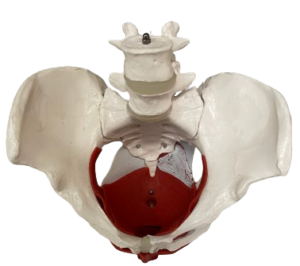Whether you have had a vaginal or cesarean birth, your body has gone through a tremendous physical event. As your pelvic floor and core heal, many changes happen within your body (on top of all the changes your body goes through trying to care for a new tiny human). With all these changes, the chances you encounter functional issues within your body drastically increases. Below, we will discuss the most common functional issues for postpartum patients and how pelvic floor physical therapy can help.
Urinary Leakage: Common but Not Normal
Why do I leak?
Leakage is very common postpartum, but it’s not considered normal past the 6-week mark. The cause of leakage postpartum is more complex than you’d think; it’s not just weakness.
During pregnancy, we have a baby sitting on our pelvic floor and taking up space in our abdomen and pelvis. The bladder and other organs in the pelvis and abdomen compress, and there is an increase in pressure in your trunk. Your pelvic floor muscles work overtime to support the baby and other organs while your pelvis loosens in preparation for labor and delivery. After birth, there is a sudden drop in the pressure in your trunk, and your muscles lengthen in both your abdomen and pelvic floor. Because of this, restrictions may form, and your organs may shift with the excess space in the abdominopelvic cavity. Additionally, some women sustain injury to their tissue if they have a c-section, episiotomy, or have perineal tears. All of these changes cause the body to be vulnerable to potential dysfunction, including urinary leakage.
How can I stop leaking?
From birth to 6 weeks postpartum, I encourage patients to focus on rest and recovery as much as possible to allow these muscles to recover and reduce the risk of dysfunction. If leakage and/or bleeding increases during this time, it’s an opportunity to stop and listen to what your body is trying to tell you: the activity you’re doing is too hard, and your muscles still need rest. Gentle breathing and pelvic floor activation exercises can be helpful during this period as well. Talk to a pelvic floor physical therapist before the birth of your baby to find out specific exercises that are safe for the early postpartum period. Over the first 6 weeks, leakage should become less in quantity and frequency.
If you are continuing to have urinary leakage past the 6-week postpartum mark, this is an indication that those mu
scles and other tissues need a little more help in the recovery process. Your pelvic PT can assess for the cause of your symptoms and tailor an individualized treatment plan for you.
Pelvic Pain Postpartum
Why does my pelvis still hurt?
The pelvic girdle is made of a ring of bones joined together at three joints with a sling of muscles and connective tissue known as the pelvic floor. The pelvic floor supports your spine and organs and contributes to your bowel/bladder and sexual function.

During pregnancy, connective tissues joining the bones of your pelvis become looser, increasing your joint mobility to allow your baby to descend down and out of your pelvis during birth. This can cause Symphysis Pubis Dysfunction (SPD) and/or sacroiliac (SI) joint pain during pregnancy. SPD is generally localized to the area in the front of your pelvis, whereas SI joint pain is generally across your lower back on one or both sides or can cause “sciatica” like pain.
So what can I do for my pelvic pain?
A pelvic floor PT can help treat these conditions during your pregnancy to reduce pain, maintain function until birth, and reduce dysfunction postpartum. Most of the time, pelvic girdle pain resolves within the first week postpartum as your joints settle back into their natural position. However, some women can continue to experience pain past this time, especially if they give birth on their back or side, as the compression on the pelvis causes the other joints to move excessively.
In addition to pain in the joints of the pelvis, some women experience pain with sex. Some contributing factors to this include hormonal tissue changes, joint mobility changes, healing of episiotomies and tears postpartum, and changes in muscle flexibility. Whatever it is that’s contributing to it, it’s not “normal” and you don’t have to live with it. Again, it’s a sign that your pelvic floor needs help to heal and function properly.
Whether you are having pelvic girdle or pelvic floor pain, you don’t have to suffer. In pelvic physical therapy, we assess your back, pelvic girdle, hips, abdomen, and pelvic floor to address the specific imbalances contributing to your pain and help you get back to the activities you love.
Abdominal Separation
What is abdominal separation?
Abdominal Separation, known as Diastasis Rectus Abdominus (DRA), is where the rectus abdominus muscles, or your “6 pack muscles”, separate at the midline of the abdomen by greater than two fingertips distance. This separation can cause bulging of your abdominal tissue at the separation. DRA commonly develops in the third trimester of pregnancy as your baby grows rapidly, but it can develop earlier. The hormonal changes that allow your joints to be more mobile also impact the connective tissue between your abdominal muscles, allowing them to stretch apart. Many women won’t notice it forming during pregnancy, as this tissue is tense with the pressure of the baby in their abdominal cavity.
How does DRA affect me?
After birth, the tissue naturally begins to tighten up again and the abdominals come back together. The healing time of your tissue and whether those tissues will come all the way back together varies from person to person. However, the bigger concern is whether or not your core muscles are functioning well enough to prevent bulging and stretching of that tissue during activities. If the deeper muscles are not functioning well, you will continue to stress the DRA, which may lead to pain and/or poor pressure management in the trunk.
This is why a slow return to gentle activities in the early postpartum weeks is so important. In addition to increased urinary leakage and bleeding, we need to watch for doming/bulging/coning of the abdomen, as it is a sign that you are not quite ready for that activity. In pelvic physical therapy, we screen for DRA and address restrictions, weakness, and coordination issues that lead to the dysfunctional bulging of the abdomen to allow you to return to the activities that you love.
Other Issues Postpartum
Unfortunately, this article can’t cover all the issues that can present postpartum. In addition to what has been discussed above, we also encourage patients to seek postpartum PT if they are having other symptoms such as difficulty with arousal/orgasm, prolapse, constipation, hip pain, back pain, carpal tunnel, and/or mom thumb/wrist.
What Can I Do Now to Address These Issues?
During pregnancy:
- Stay active! This should include mobility, relaxation, and strengthening of your pelvic floor muscles.
- Ideally, address pain and functional limitations early in your pregnancy.
- We highly recommend a birth prep assessment before the birth of your baby. Here, we can provide exercises to prepare you and your body for birth and information to help in the early weeks of your postpartum recovery.
After Birth:
- Rest is crucial! Limit your activity in the first two weeks postpartum. Gently and gradually increase activities thereafter. If bleeding or leakage increases, it’s a sign to rest and back off your activity level for a few more days.
- Breathing exercises for your pelvic floor mobility and activation, and “huts” for core engagement.
- Chest opening exercises to reduce strain on your neck and back from caring for your baby.
- Set up a 6-week postpartum visit with one of our pelvic physical therapists, or come in earlier if you are having a lot of pain.
Why Pelvic Floor Therapy?
Pelvic physical therapists are orthopedic PTs who specialize in the pelvic floor muscles, fascia, and nerves. This specialized training gives us the unique ability to treat postpartum issues. During your first visit, your examination may include looking at posture, breathing pattern, balance, functional movements, and an evaluation of your pelvic floor and abdomen. If you are having other pain such as neck, back, or upper extremity pain, we will also assess those areas, time permitting. Based on our findings, we will tailor a personalized program to address your concerns and work toward your functional goals.
So to answer the initial question: yes, we believe everyone should have pelvic floor therapy postpartum, even if it is just a one visit check-in to see how you’re doing. There are so many changes to the body from pregnancy though postpartum, everyone’s experience is different, and it is our job to identify and help you with your specific issues and needs to get you back on your feet (literally and figuratively) and back to the things you love.
If you have any questions about anything discussed above, give us a call or send us a message, we would love to talk with you!




